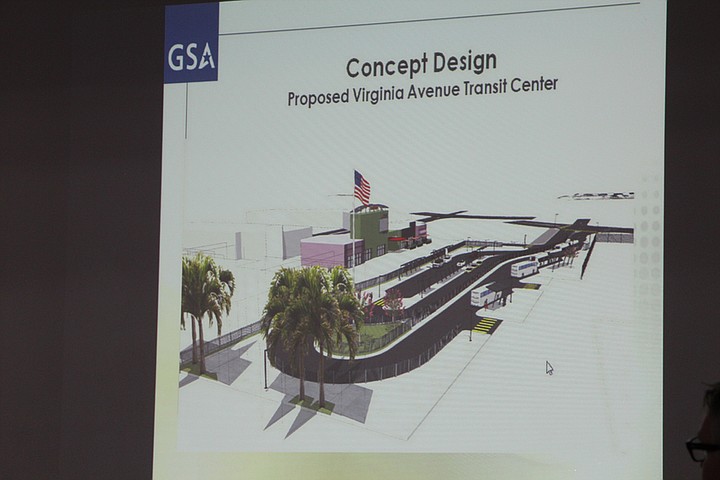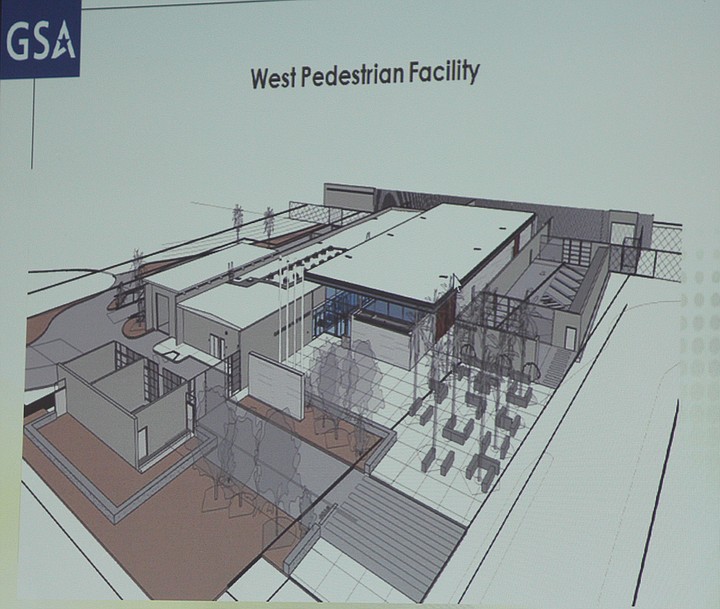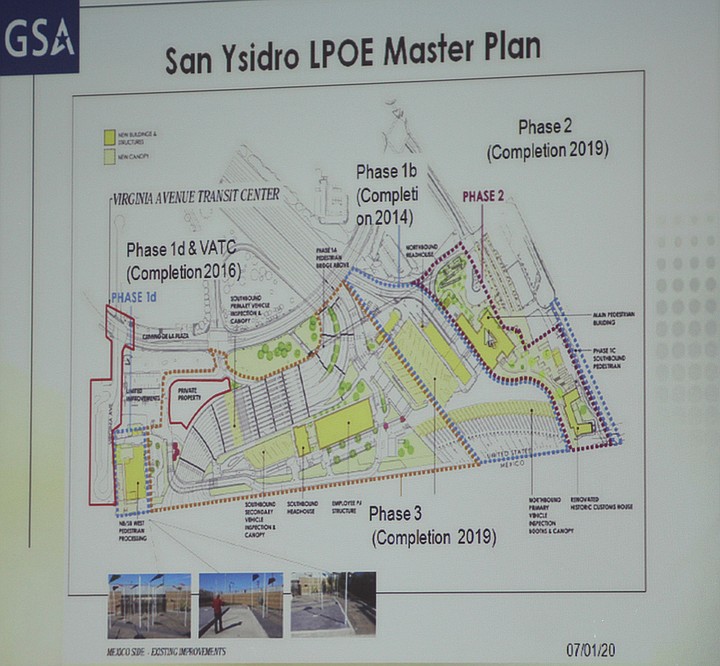 Facebook
Facebook
 X
X
 Instagram
Instagram
 TikTok
TikTok
 Youtube
Youtube

On Thursday, August 6, the General Services Administration (GSA) gave an update to about 20 community members at The Front art gallery about the ongoing reconfiguration of the San Ysidro Land Port of Entry.

Anthony Kleppe, Regional Land Port of Entry program manager for the GSA, opened the meeting saying, “We try to get out to the community a couple times a year at a minimum, and so it’s been about six months. We thought it was important to come back and talk about what’s going on with the property.”
The GSA completed phase one of construction in December 2014, which included an expanded number of northbound vehicle processing lanes. Phase two will include restoration of the Customs House, a building erected in 1932 and currently on the National Register of Historic Sites. It will accommodate six northbound pedestrian processing booths. A realignment of Interstate 5 will be part of phase three, and both phases should be completed by 2019.


San Ysidro, however, will already receive a Pedestrian West Facility and a Virginia Avenue Transit Center in Summer 2016. Located adjacent to the Las Americas Outlet Mall, the GSA already unveiled designs for the Pedestrian West Facility back in May 2014. At the time, community members said it looked like a “road stop bathroom.” The GSA presented the same design at The Front, this time without public comment. The Pedestrian West facility will have ten northbound and two reversible pedestrian inspection booths.
The GSA also unveiled the new transit center artist renderings, which will accommodate four buses, ten taxis, 18 parking-only vehicles, and five pedicabs. A road meant for pick up and drop off, Barry Simon asked if time limits will be imposed on vehicles.
Kleppe explained, “At completion of the project, we’re going to be handing that project over to the city and so any questions about the operation or use of the facility probably should be pointed over to the city.”

Barry Simon, an owner of properties along the border and also the original developer of Las Americas Outlet Mall, then asked where the UETA duty-free store will be located. In June 2014, chairman and chief operating officer of Duty Free Americas, Simon Falic, proposed that when GSA takes his property by eminent domain to widen Interstate 5, he be allowed to keep three acres of land located next to the pedestrian crossing. He would then build a parking structure with a heliport on the roof.
Kleppe said negotiations were underway and his GSA colleague revealed that the property will cover approximately 1.3 acres. There might also be an access road that UETA will have to build.
Kleppe said, “How UETA decides to utilize the site that is not acquired by the U.S. government is really not something we should be speaking about. That’s their business.”
“I have a problem with that,” said Simon, “because you’re dealing with public funds and public rights and I as a citizen and competitor of UETA, I want to know what you’re doing. That should be wide open.”
“Once we have negotiated the purchase and sale agreement, that becomes a matter of public record,” Kleppe said. “I will say that through the entire process we have worked with our attorneys to make sure that we have done nothing that is improper or that violates any code or requirements.”


On Thursday, August 6, the General Services Administration (GSA) gave an update to about 20 community members at The Front art gallery about the ongoing reconfiguration of the San Ysidro Land Port of Entry.

Anthony Kleppe, Regional Land Port of Entry program manager for the GSA, opened the meeting saying, “We try to get out to the community a couple times a year at a minimum, and so it’s been about six months. We thought it was important to come back and talk about what’s going on with the property.”
The GSA completed phase one of construction in December 2014, which included an expanded number of northbound vehicle processing lanes. Phase two will include restoration of the Customs House, a building erected in 1932 and currently on the National Register of Historic Sites. It will accommodate six northbound pedestrian processing booths. A realignment of Interstate 5 will be part of phase three, and both phases should be completed by 2019.


San Ysidro, however, will already receive a Pedestrian West Facility and a Virginia Avenue Transit Center in Summer 2016. Located adjacent to the Las Americas Outlet Mall, the GSA already unveiled designs for the Pedestrian West Facility back in May 2014. At the time, community members said it looked like a “road stop bathroom.” The GSA presented the same design at The Front, this time without public comment. The Pedestrian West facility will have ten northbound and two reversible pedestrian inspection booths.
The GSA also unveiled the new transit center artist renderings, which will accommodate four buses, ten taxis, 18 parking-only vehicles, and five pedicabs. A road meant for pick up and drop off, Barry Simon asked if time limits will be imposed on vehicles.
Kleppe explained, “At completion of the project, we’re going to be handing that project over to the city and so any questions about the operation or use of the facility probably should be pointed over to the city.”

Barry Simon, an owner of properties along the border and also the original developer of Las Americas Outlet Mall, then asked where the UETA duty-free store will be located. In June 2014, chairman and chief operating officer of Duty Free Americas, Simon Falic, proposed that when GSA takes his property by eminent domain to widen Interstate 5, he be allowed to keep three acres of land located next to the pedestrian crossing. He would then build a parking structure with a heliport on the roof.
Kleppe said negotiations were underway and his GSA colleague revealed that the property will cover approximately 1.3 acres. There might also be an access road that UETA will have to build.
Kleppe said, “How UETA decides to utilize the site that is not acquired by the U.S. government is really not something we should be speaking about. That’s their business.”
“I have a problem with that,” said Simon, “because you’re dealing with public funds and public rights and I as a citizen and competitor of UETA, I want to know what you’re doing. That should be wide open.”
“Once we have negotiated the purchase and sale agreement, that becomes a matter of public record,” Kleppe said. “I will say that through the entire process we have worked with our attorneys to make sure that we have done nothing that is improper or that violates any code or requirements.”
Comments